Contents
- 1. Akashdevata (deity of absolute ether)
- 2. Vayudevata (deity of absolute air)
- 3. Tejdevata (deity of absolute fire)
- 4. Apadevata (deity of absolute water)
- 5. Pruthvidevata (deity of absolute earth)
- 6. Guardian deities of the directions (dikpal)
- 7. Grahadevata (deities of planets)
Main deities associated with life on the earth
The deities of absolute ether (akash), absolute air (vayu), absolute fire (tej), absolute water (apa) and absolute earth (pruthvi) given below represent the five main cosmic elements. More information on them is given in ‘Science of Spirituality : Chapter 24 – Creation of the Universe’.
1. Akashdevata (deity of absolute ether)
A. Mission and special features
Absolute ether (akash) is one of the five cosmic elements. All the cosmic elements originate from the absolute ether element and finally merge into it.
Rainfall and its effects on the earth is the first function of the deity of absolute ether. It is because of rainfall that creation occurs. In other words the deity of absolute ether is life-endowing. It is mainly considered as the deity of creation.
Death occurs when lightning strikes. Thus it is also the bestower of death.
Ability and manifest energy
Ability : Creation 75%, sustenance 20% and dissolution 5%
Manifest energy : 10%B. The idol : Idols of this deity are not found anywhere. This is but natural because absolute ether is colourless and formless.
2. Vayudevata (deity of absolute air)
A. Creation : The Rugveda (10.95) states that absolute air (vayu) was created from the first breath of the Absolute Being. Absolute air originated from absolute ether (akash). It is the deity of the cosmos (antariksha). The words absolute air (vayu) and air (vata) are used synonymously. Nevertheless absolute air is the deity and air is one of the five cosmic elements. Absolute air is always associated with Lord Indra and air with rain.
B. Mission and special features
The absolute air element is the symbol of the principle of speed as well as the principle of vital energy and the regulator of the energy of action (kriyashakti). The five vital energies and five sub-units of vital energy are considered the ten forms of absolute air (Yogadarshan). It is because of its velocity that this deity is believed to possess the speed of the mind.
Creation of food, nurturing creation and bestowing all living beings with strength, etc.
Ability and manifest energy
Ability : Creation 60%, sustenance 10% and dissolution 30%
Manifest energy : 10%C. Science behind the idol : According to the Vishnudharmottar Puran the idol of the deity of absolute air should have two arms, a scarf draped around the neck with each end held in either hand, clothes blown by the impact of air, a gaping mouth and dishevelled hair. Other holy texts state that the idol possesses four arms. Sometimes the deity appears seated on a throne or a deer. It has a thousand beautiful eyes and an effulgent chariot. A thousand horses draw the chariot. It holds a flag, a staff or a goad in the hand. In some idols the upper two arms hold a fan and a flag and the lower two are held in postures (mudras) depicting a blessing and assuring protection.
3. Tejdevata (deity of absolute fire)
The deity of absolute fire has three forms, the sun in the sky, lightning in the atmosphere and fire on the earth. (Indra is considered the deity of the sky, Varun the deity of the atmosphere and Agni the deity of the earth.) Of these the Sun deity and the fire deity are the two main forms worthy of worship.
3.1 The Sun deity
This deity is not the sun in the sky, but is the one from which the basic absolute fire element is created. Some contexts also refer to the visible sun which symbolises the subtle sun.
A. Other Names: The Sun deity has several Names. Twelve of them are names of the adityas. When performing suryanamaskar (the solar bent posture) the following twelve Names are chanted : 1. Mitra, 2. Ravi, 3. Surya, 4. Bhanu, 5. Khaga, 6. Pushna, 7. Hiranyagarbha, 8. Marichi, 9. Aditya, 10. Savitru, 11. Arka and 12. Bhaskar.
The word aditya (आदित्य) is derived from adi (आदि) and atya (अत्य). Adi means from the beginning and atya means till the present moment.
The table below gives the Names of the Sun deity suitable for chanting in different months. If the Name of the Sun deity which matches the month is considered as 100%, then in comparison the other Names are of only 95% importance for that month.
| Season | Month | Name of the Sun deity |
| 1. Summer | Chaitra | Dhata |
| Vaishakh | Aryama* | |
| 2. Monsoon | Jyeshtha | Mitra |
| Ashadh | Varun | |
| Shravan | Indra | |
| Bhadrapad | Trivasvan | |
| 3. Winter | Ashvin | Parjanya |
| Kartik | Pusha | |
| Margashirsha | Anshuman | |
| Poush | Bhag | |
| 1. Summer | Magh | Tvashta |
| Phalgun | Vishnu |
* Aryama is the deity which endows eyes with the radiance of the sun.
B. Creation: There are several references about His birth as the son of Indra, the son of Mitra-Varun, the son of Som, the son of Indra-Som, the son of Indra-Vishnu, the son of Indra-Varun, the son of Agni and Dhata and that of Agniras.
C. Mission and special features
Priest of the deities
Creation of the universe
The life of all living beings is dependent on the sun as it gives both radiance and light.
The Sun deity eliminates physical illnesses and endows longevity.
The chariot of the Sun deity has one wheel and seven horses. Serpents are the reins. The chariot flies through the sky without touching the ground. Its charioteer, Arun does not have legs. Despite this due to His sattva component the Sun deity is constantly able to travel through the entire sky, that is why poets have praised Him. When the chariot of the Sun deity approaches the earth the charioteer is seen first and only then the Sun deity. That is why the advent of dawn that is rise of Arun (arunoday) occurs before sunrise (suryoday) !
Ability and manifest energy
Ability : Creation 40%, sustenance 10% and dissolution 50%The rotation of the sun is akin to this. Its stage of ‘sustenance’ of 12 noon lasts only for a short period. The stage of ‘creation’ preceding it and the stage of ‘dissolution’ following it lasts for a longer duration.
Manifest energy : 10%
Information on surya frequencies is given in ‘Science of Spirituality : Chapter 20 – Holy festivals, point – Gudhipadva’.D. Science behind the idol: In the ancient times the image of the sun was represented by carving or drawing a round dish with rays of sunlight. It was during the reign of the Mouryas and the Shrungas that idols in a human form began to be used in ritualistic worship. Temples of the Sun deity were mostly constructed during the reign of the Gupta dynasty. One comes across these temples in Gvalior, Mandasaur, Indore, Multan, Konark, Kashmir, Khadayat (Gujarat), Patan, Gaya, Jhashi, Nashik, Aurangabad, etc.
E. Family
Consorts: According to the Rugveda – Usha, Pratyusha, Sandnya and Chaya
According to the Matsya Puran – Radnyi, Savarna, Chaya and Suvarchasa
Sons : Nasatya, Dastra (Ashvinikumars), Revant, Vaivasvat Manu [deity of making an offering to ancestors (shraddhadev)], Yama, Yamuna, Savarni Manu, Shani, Tapati, Vishti, Prabhat and Revat
Charioteer and elder brother : Arun
The one who carries a staff : Raja and Shrosh
Writer : Pingal
Guardian deities of the entrance (dvarpal) : Kalmash and various birds from creation
Adityas : The twelve months of the year have one aditya each and they assist the sun in governing the cycle of Nature. (Aditya is also a Name of the Sun deity.)
Deities in the retinue: ‘Mitra is a Vedic deity. Based on the quality of “governing the path of the sun”, in the Brahman holy text Mitra is associated with the day and Varun (deity of rain) with the night. In literature on rituals of five sacrifices (yadnyas) Mitra is referred to as the white and Varun as the black animal. This will illustrate how Mitra and Varun were considered as deities of the day and night respectively. The indistinct statement in the Vedic texts which states that Mitra is the Sun deity is supported by the holy text, Avestya of the Zoroastrians.’(1) The sun seen on the earth is referred to as Mitra. Mitra acquires frequencies of radiance through a series of suns beginning from the basic Sun deity. All the satellites of the sun acquire vital energy (pran) or radiance (tej) from the Sun deity.
F. Spiritual practice of the Sun deity
1. Intolerable: First chant any Name of the Sun deity and then the Name of any superior deity which one has not chanted before, each for two minutes. Record both the spiritual experiences. Then read the section below.
At two satsangs (spiritual meetings) there was no seeker who had been chanting Lord Pandurang’s Name. After chanting the Names Pandurang (of a superior deity) and Ravi (of the Sun deity) the resultant spiritual experiences are recorded in the table below.
| Satsang | Chanting of which Name? |
Felt pleasant |
Felt distressed* |
Felt nothing |
Total |
| First | Ravi | 7 | 7 | 10 | 24 |
| Pandurang | 7 | 0 | 17 | 24 | |
| Second | Ravi | 8 | 8 | 9 | 25 |
| Pandurang | 6 | 1 | 18 | 25 |
* Palpitations, exhaustion, feeling radiance or burning in the eyes, inability to concentrate, etc.
The reason for distress after chanting the Name of the Sun deity in contrast to that of Pandurang is that the former is spiritual practice of the absolute fire (tej) element. One is not distressed by undertaking spiritual practice of the absolute fire element and spiritual progress occurs successfully only if spiritual practice of the absolute earth (pruthvi) and absolute water (apa) elements is completed before it.
2. Worship of the sun and moon : Before reading the section below chant Chandra (a Name of the Moon deity) and Surya (a Name of the Sun deity) each for two minutes and record your experience.
At a satsang seekers experienced the following after chanting Surya and Chandra.
| Chanting of which Name? |
Felt pleasant |
Felt distressed |
Felt nothing |
Total |
| Surya | 29 | 2 | 10 | 41 |
| Chandra | 4 | 4 | 33 | 41 |
The table above will illustrate that the moon is not a deity worthy of worship. This is because the moon is the deity which activates the mind whereas a seeker wants exactly the opposite, the dissolution of the mind. For that, worship of the sun proves beneficial.
3. Other types : The Samba Puran provides information on spiritual practice of the sun. Akin to the Shaiva and Vaishnav sects a sect of worshippers of the sun had been founded. Later this sect adopted the attitude of sorcerers (tantriks). The ritual of sandhya performed in the morning and mystic prayers (upasthan) are types of spiritual practice of the sun. Suryanamaskar (the solar bent posture) is also performed. When performing it, along with the posture (asan) and pranayam (regulated breathing) one also acquires the benefit of chanting the Names of the Sun deity simultaneously. The Gayatri mantra is also a form of worship of the Sun deity.
3.2 Agnidev (deity of fire)
A. Mission and special features
Providing the path for dispersion of deities from the absolute ether (akash) element to the site of the fire sacrifice (yadnya).
Every spiritual rite (sanskar) is performed in the presence of fire. In the Indian scriptures of deities, Agni is accorded status only next to Indra, the king of deities. In the Rugveda, Agni is referred to as the presiding deity of the home (gruhapati) and an excellent guest. He is the liason between deities and man. Since it is He who delivers the oblations offered in the fire (havi) by man to deities in every spiritual rite He is invoked on the altar (sthandil) first. The Name of Agni used in every spiritual rite varies. After the ritual of invoking Agni, oblations are offered to the principal deities through it and then the respective spiritual rites are performed.
Presiding deity of the south-western direction
B. Science behind the idol: The idol has three eyes, four teeth and four arms. It sports a beard and smoky grey clothing and is red in complexion.
C. Family
Consorts : Svaha and Svadha
‘Svaha : She is one of the consorts of Lord Agni. When performing a sacrificial fire (hom), at the end of a mantra an oblation is offered after chanting svaha because it is believed that a sacrificial fire bestows benefits only if svaha is uttered in this way. When praying to Agni, Sage Grutsamad says, “O Agni deliver the oblation offered through the fire amidst chanting of the word svaha to deities” (Rugveda 2.3.11).
Svaha is the daughter of Daksha and Prasuti and the consort of Agni. She acquired the ability to deliver food to deities because of Her austerities. She gave birth to four sons namely the three fires Pavak, Pavaman and Shuchi and Svarochish Manu (Brahmavaivarta Puran 2.40).
The Devibhagvat narrates Her story as – Lord Vishnu manifested in the form of a sacrificial fire so that deities would get food. Brahmans began to offer oblations in that sacrificial fire. However Agni would not deliver that part of the oblation to the respective deity. Hence the deities approached Lord Brahma once again. Then He meditated upon the female deity (devi) and She manifested Herself in the form of a woman. Lord Brahma named Her Svaha and instructed Her to deliver oblations which were offered in the fire amidst chanting of Her Name to the deities. She accepted the task. Then Agni married Her and She bore three sons, their names being Garhapatya (the fire worshipped in the home), Dakshinagni (the fire placed in the south) and Ahavaniya (the sacred fire lit for a specific spiritual purpose). Since then Brahmans began to offer oblations suffixing svaha to the mantra and deities began to receive their share of oblations. When offering an oblation the Name of the deity is chanted along with the dative case. For example ‘Indraya svaha’ means ‘I offer this oblation to Indra’. It is said that Svaha should be worshipped with the mantra “Om rhim shrim, vahnijayayai devyai Svaha’ (ॐ र्हीं श्रीं वह्निजायायै देव्यै स्वाहा ।)”.’(2)
Vehicle : A chariot drawn by four parrots
D. Spiritual practice: Hindus and Zoroastrians worship Agni.
Agnihotri : He is the one who performs the ritual of agnihotra, that is concentrates on Agni and keeps a fire lit in his home throughout his life. He ritualistically worships the Garhapatya, Ahavaniya and Dakshinagni fires everyday in the morning and evening. Some agnihotris offer oblations to the Garhapatya fire in the morning and evening and to the Ahavaniya and Dakshinagni only during the day. The sacred fire is offered oblations twice, at sunrise in the morning and after sunset in the evening. In the morning, an oblation is offered to the Sun deity and in the evening to Agni. Agnihotris also give offerings to all living beings and the seven great sages (saptarshis) along with the fire. An agnihotri couple has to carry the fire with it even during travel. An oblation offered to it consists of sacrificial firewood (samidha), milk and water.
4.1 Apadevata (deity of absolute water)
4.1 Meaning
Absolute water (apa) is one of the five cosmic elements. It is considered as a deity. Its visible forms are water, a river or a fluid.
4.2 Mission
Creation of animate and inanimate Nature
Overcoming disease
Cleansing and purifying others, washing away dirt
It is invoked to liberate oneself from immoral acts, demerits and curses.
4.3 Idols
Idols of this Vedic deity are not found anywhere.
4.4 Associated deity : Varun (deity of rain)
A. Origin and meaning: Sayanacharya has derived this word Varun (वरुण) from vru (वृ) meaning to encompass or envelope. Varun is the one who entraps sinners in bondage or envelopes them like darkness.
B. Other Names: Pracheta, Pashi, Yadsampati, Appati (master of water).
C. Mission and special features
Control over reservoirs of water
‘Not only is the Vedic word asur (असुर) meaning demon far more ancient than the Sanskrut word sur (सुर), but is also the root word. Asur is derived from two words asu (असु) and r (र). R means the one who has mastery over something. He is thus the one who possesses asu, the element of supernatural power which is fluid in nature. Deities, man, animals and all other objects in the universe possess this emotion (rasa) of supernatural power and on account of it all of them are able to sustain themselves and carry out activities. This energy of emotion of supernatural power itself is the Great Illusion (Maya) of Varun. This illusion is the energy possessing the qualities of planning, liberating (nirvan) and creating.’(3)
According to the Purans Varun is the presiding deity of the western direction and of the region of serpents (naglok).
Ability and manifest energy
Ability : Creation 50%, sustenance 40% and dissolution 10%
Manifest energy : 10%D. Science behind the idol : He is depicted as big bellied, has four arms and is seated on a chariot drawn by seven swans. He holds a lotus and a noose in the two right hands and a conch and a casket filled with gems in the left. His consort, Gouri is seated on His left lap and Ganga and Yamuna, the two rivers are depicted standing on His either side (Vishnudharmottar Puran).
E. Family
Consorts : Varuni, Jyeshtha and Shitatoya
Son : Maharshi Bhrugu. Bhrugu acquired knowledge about the principle because of which spirits survive and into which they merge, from His father. At that time though actually it was nightfall, it appeared like twilight. Hence Varun is considered as the deity of the night or the deity of the apan vital energy.
F. Ritualistic worship : ‘During ritualistic worship of any deity, Varun is invoked onto a pot (kalash). It is customary to invoke Varun after installation of a pot and to worship Him at the beginning of various spiritual rites such as Punyahavachan and several other rituals performed to avert evil or to acquire good fortune.’(4)
5. Pruthvidevata (deity of absolute earth)
5.1 Origin and meaning
‘Prath (प्रथ्) meaning pervasive is the root from which the word pruthvi (पृथ्वी) has been derived. “प्रथते विस्तारं याति इति” meaning “that which is pervasive is the pruthvi” is how the absolute earth has been defined.’(5) Pruth (पृथ्) means particles. Thus the earth, pruthvi (पृथ्वी) is the one which is composed of several particles. Absolute earth is one of the five cosmic elements and is considered a deity.
5.2 Some other Names
Bhu, Bhuma, Bhumi, Vishvambhara, Dharitri, Kshiti, Vasudha, Mahi, etc. are some of its Names. Bhuma is the one who expands and nurtures. Since this phenomenon occurs on the earth she is called Bhuma.
5.3 Special features
A. Qualities: Tolerance and forgiveness. The earth endures the cruel acts of evildoers, pardons them and even nurtures them. In the context of evildoers it is said, ‘ते मृत्युलोके भूमिभारभूता मनुष्यरुपेण मृगाश्चरन्ति ।’ meaning animals in human form (unrighteous people) on the earth (mrutyulok) become a burden to it.
B. Fragrance: This is a feature of the earth.
5.4 Ability and manifest energy
Ability : Creation 10%, sustenance 20% and dissolution 70%
Manifest energy : 10%
5.5 Idols
One does not come across idols of this deity.
5.6 Spiritual practice
A. The earth is worshipped in the form of snake holes. This form of the earth is referred to as Santeri. The form of the earth as Bhumaka is ritualistically worshipped by performing ritualistic worship of the kitchen platform.
B. Although we consider the earth as a deity we touch Her with our feet, walk over Her, dirty Her, etc. Hence every morning after waking up, before placing the feet on the ground the following prayer is recited.
‘समुद्रवसने देवी पर्वतस्तनमण्डले ।
विष्णुपत्नि नमस्तुभ्यं पादस्पर्शं क्षमस्व मे ।Meaning : I offer obeisance to You O deity of the earth, the consort of Lord Vishnu who is donned with clothes in the form of the sea and has breasts in the form of mountains. Forgive me for touching You with my feet.’(6)
C. Lord Vishnu is the sustainer. The earth too performs the same function. Hence She is considered as Vishnu’s consort. At times Shridevi (Lakshmi) and Bhudevi (deity of the earth) are depicted on either side of the idol of Lord Vishnu.
5.7 Forms
The earth becomes a mother only after becoming ‘moist’. Hence in the verse (stotra) Shrisukta with reference to mud and moisture it is said “because of you She bore progeny and became a mother”. The lotus is associated with both muck and moisture.
The menstruating woman (ambuvachi) : Rajaha (रज:) means minute particles and rajasvala (रजस्वला) means the woman undergoing menses. According to the Krushiparashar (6th century A.D.) a farmer who wishes to grow a crop is prohibited from sowing seeds for three and a half days between the end of the Hindu lunar month of Jyeshtha and the beginning of Ashadh because at that time the earth is menstruating. If this rule is violated then it amounts to a sin and that individual gets destroyed. Based on the date (tithi) during the period between the end of the Mruga and the beginning of the Ardra lunar asterisms (nakshatras) for three days, the earth is in Her menstrual cycle. This state is referred to as ‘ambuvachi’. According to the regional variation these days vary.
1. In the Indian state of Assam the temple of the female deity Kamakshi is kept closed for three days from the sixth (shashthi) / seventh (saptami) day till the tenth (dashami) / eleventh (ekadashi) day of the bright fortnight of the Hindu lunar month of Ashadh. On the fourth day after ritualistic worship the temple doors are opened. To signify menstruation of the deity, on that day, devotees are given a piece of red cloth as offering (prasad). The ‘Sat’ [seventh day (saptami)] festival is celebrated here.
2. In Kashmir the festival of radnyisnapan, bathing of the earth, the consort of the Sun deity after Her menstruation, is celebrated from the fifth (panchami) to the eighth (ashtami) day of the dark fortnight of the Hindu lunar month of Chaitra.
3. In Keral in India the rituals of Tripukharattu and Ucharal are performed in the month of January or February in which for three days the house, courtyard and garden are neither swept nor watered or smeared with cowdung.
4. In Orissa in India in the last few days of the Hindu lunar month of Jyeshtha or the first one or two days of Ashadh the festival of rajotsav (menstruation) is celebrated.
The mother / nurturer: Obeying the directives of Sage Jamadagni, Parshuram beheaded His mother, Renuka. The head is worshipped as the female deity Yallama and the body as Bhudevi, Lajjagouri, Lanjika, Yogambika, Nitambini, Kotavi (kot means nude), Chinnamasta, etc. Lanjika refers to the great birth passage (mahayoni) of the entire universe. Only the body represents creation and the organs of sustenance. The female deity is primarily the deity of Nature and its nurturer too. That is why She is worshipped in the form of the birth passage which represents creation and the breasts which represent nurture.
Nirruti : ‘निर्गत: ऋत: यस्मात्’ means Nirruti is the one in whom the path to know the ultimate truth is deficient. She is the deity of death. She exists in the form of a pot (kumbha). Formerly a dead child used to be buried in a pot. A pot resembles an uterus. It suggests that birth occurs through the womb and that after death once again one has to return to the womb.
5.8 Spiritual experience
‘Baba (H.H. Bhaktaraj Maharaj): Spiritually the moon too is considered a great deity. The moon is the deity of the mind and imparts tremendous amount of Serenity (Shanti). Your trip to the moon must have had a great impact on your mind.
Edgar Mitchell: Of course the moon makes the mind tranquil. But in this journey to the moon the most fascinating experience that I had was the vision of the earth from the moon.
Baba: What effect did that have on you?
Edgar Mitchell: I think I can describe that vision as “a glimpse of an experience of the soul, an experience of non-duality between the soul and the universe”. I experienced that for approximately three hours.’(7)
6. Guardian deities of the directions (dikpal)
6.1 Origin and meaning
The word dikpal (दिक्पाल) has been derived from two words dik (दिक् ) meaning direction and pal (पाल) meaning sustainer and protector. Dikpal is thus the deity who guards and protects the directions. Origin and meaning of the word disha (दिशा) is given below.
Dish danayati (दिश् दानयति) – the medium through which one gets what one desires.
Da dan (द दान) – that which endows
Di druk (दि दृक्) – the medium through which one can view.
To understand what one gets from a direction let us see what it generally consists of.
Sattva frequencies come from the main directions – north, south, east and west and consist of pure particles (pavitraks).
Raja frequencies come from the north-east, north-west, south-east and south-west sub-directions.
Tama frequencies are emitted by the downward direction arising from the centre of the earth.
Things associated with frequencies are obtained from the respective directions.
6.2 Other Names
Dishasvami and Lokpal
6.3 Directions and their guardian deities
The table given below gives information on the eight main directions and their guardian deities (dikpal). According to some schools of thought the downward and upward directions are also included in the directions taking their number to ten. They have their own guardian deities. At times the eight directions are spoken of in the context of the eightfold Prakruti and pure particles arising from the eight directions.
| Direction | Guardian deity of the directions |
Complexion | Arms | What does the hand adorn? |
Vehicle |
| Main directions | |||||
| 1. East | Indra | Yellow | Two | A vajra and breasts |
Airavat (the divine white elephant) |
| 2. West | Varun | White | Two | A noose of serpents and a conch |
Crocodile |
| 3. South | Yama | Black | Two | A staff and a spear |
Male buffalo |
| 4. North | Kuber | Yellow | Two | A goad and a mace |
Man |
| Intermediate directions | |||||
| 1. South-east (agneya) |
Agni | Crimson | Two | A wooden spoon (srucha)* and a water pot (kamandalu) |
Billy goat |
| 2. South-west (nairrutya) |
Nirruti** | Blue | Two | A sword and a staff |
Corpse |
| 3. North-west (vayavya) |
Vayu | – | – | – | Deer |
| 4. North-east (Ishanya) |
Ishan | – | Two |
A skull and |
– |
* It is used in a sacrificial fire (yadnya).
** Refer ‘Nirruti’
6.4 Mission and special features
Though sattva frequencies are emitted by all the eight directions, their proportion varies. Stand facing each of the four walls of a room, not knowing the directions for one minute each. Record your experience and then read the following paragraph.
There were 34 seekers at a satsang (spiritual meeting). When they performed this experiment the following spiritual experiences were recorded.
| Felt what? | East | West | South | North |
| 1. Pleasant | 15 | 11 | 3 | 24 |
| 2. Distressed | 8 | 6 | 10 | 2 |
| 3. Nothing | 11 | 17 | 21 | 8 |
| Total | 34 | 34 | 34 | 34 |
This will explain why a seeker should not face southwards during spiritual practice. Due to frequencies coming from the southern direction the master of which is Yamaraj (deity of death), distress is experienced and spiritual progress does not occur smoothly. Contrary to this, since facing the east or north makes one feel pleasant, spiritual progress also occurs smoothly.
If an individual finds all directions distressing then most probably he is a psychiatric patient and if he finds all of them pleasant then his spiritual level is more than 60%. (The spiritual level of an average individual is 20%.)
Mission and special features of guardian deities of various directions are given below.
East: Light, heat, life, happiness and prosperity
West : Darkness, cold, death and destruction
South : The direction of Lord Yama and inauspiciousness
North : Spirituality and attainment of heaven (svargalok) after death
6.5 Science behind the idol
Eight guardian deities of the directions have been described in the Purans and Tantra texts. They do not have temples of their own.
7. Grahadevata (deities of planets)
Origin : ‘गृह्णाति गतिविशेषान् इति’ or ‘गृह्णाति फलदातृत्वेन जीवान् इति’ means planets (graha) are those which adopt specific velocities or afflict embodied souls with the motive of endowing them with auspicious or inauspicious results. Surya (Sun), Chandra (Moon), Mangal (Mars), Budh (Mercury), Guru (Jupiter), Shukra (Venus), Shani (Saturn), Rahu (the dragon’s head) and Ketu (the dragon’s tail) are the nine main planets. Although according to the physical sciences the sun is a star, in astrology from the point of view of bestowing results, it is considered as a planet. The moon is a satellite of the earth. Rahu and Ketu are not separate planets, but the points of intersection of the orbits of the earth and the moon. After the three planets Uranus, Neptune and Pluto were discovered they were named Prajapati, Varun and Indra respectively and their auspicious and inauspicious results were also described.
Information on planets
| Sun | Moon | Mars | Merc- ury |
Jupiter | Venus | Saturn | Dragon- ’s head |
Dragon- ’s tail |
|
| Parents | Aditi- Kash- yap |
Atri | Bhumi- Bhara- dvaj |
Chandra | Angiras | Bhrugu | Surya | Sinhika | In Jaimini’s family |
| Birth- place |
Kaling | Chur- ning of the celest- ial ocean |
Avanti | Magadh | Sindhu |
Bhoj- |
Soura- shtra |
Paithan | Kush- dvip |
| Gender | Masc- uline |
Femi- nine |
Masc- uline |
Neuter | Masc- uline |
Femi- |
Neuter | Feminine | Neuter |
| Comp- lexion |
Red | White | Red | Green | Yellow | White | Black | Smoky | Smoky |
| Attire | Kusu- mbi |
White | Crim- son |
Blue | Yellow | Multi- colou- red |
Black | Blue | Black |
| Class (varna) |
Ksha- triya |
Vais- hya |
Ksha- triya |
Vaishya | Brah- man |
Brah- man |
Lower class of mahar, etc. |
Shudra | Shudra |
| Princi- ple |
Fire | Water | Fire | Earth | Ether | Water | Air | – | – |
| Comp- onent |
Sattva | Sattva | Tama | Raja | Sattva | Raja | Tama | Tama | Tama |
| Taste | Pung- ent |
Salty | Bitter | Mixed | Sweet | Sour | Insipid | – | – |
| Metal | Copp- er |
Gems | Gold | Alloy | Silver | Pearl | Iron | Lead | Bronze |
| Durat- ion of prow- ess |
Day | Day and night |
Night | Day and night |
– | Day | Night | – | – |
| Period of time |
6 mo- nths |
Sec- ond |
Day | Season | Month | Fort- night (pak- sha) |
Year | – | – |
| Direct- ion |
East |
North |
South | North | North- east |
South- west |
West | South- east |
– |
| Deity | Agni | Jal | Skan- da |
Keshav | Indra | Indrani | Brah- ma |
– | – |
| Weap- on |
Ekac- hakra (discus ) |
Mace | Divine Energy (Shakti) , mace and plough |
Sword, shield and mace |
Staff | Staff | Bow, arrow and plough |
– | – |
| Assoc- iation with p- arts of human body |
Bones | Blood | Nerves | Skin | Fat | Semen | Musc- les |
– | – |
| Auspi- cious / inausp- icious |
Auspi- cious |
Ausp- icious |
Inausp- icious |
Auspi- cious |
Auspi- cious |
Auspi- cious |
Inaus- picious |
Inausp- icious |
Inausp- icious |
| Preci- ous stones |
Ruby | Pearl | Coral | Emerald | Topaz | Diam- ond |
Sapp- hire |
Gomed | Lasanya |
| Amou- nt of chant- ing |
Seven thous- and |
Eleven thou- sand |
Ten thou- sand |
Four thou- sand |
Ninteen thou- sand |
Sixt- een thou- sand |
Twent- y three thou- sand |
Eighteen thousand |
Seven- teen thou- sand |
| Reme- dies to over- come ill effe- cts of the planet |
Perfo- |
– | Perfo- rming the ritual of Graha- shanti, Vishn- usaha- sranam & chant- ing mantr- as of the planet |
chanting mantras of the planet on Monday and Wed- nesday |
Perfo- rming the ritual of Graha- shanti, periodic readings of the Guru- charitra and chanting mantras of the planet |
Perfo- rming the ritual of Graha- shanti, perio- dic re- adings of the Guru- chari- tra & chant- ing mantr- as of the planet |
Readi- |
Chanting mantras and giving donatio- ns to a manga (indivi- dual of a low commu- nity) |
Chanting mantras and giving donatio- ns to a manga |
Spiritual practice: Temples of the nine planets are found in Bangal, Orissa and other places in India.
Reference:
‘Supreme God, God, Incarnations and Deities’, published by Sanatan Sanstha.
Bharatiya Sanskrutikosh. Publisher: Pandit Mahadevshastri Joshi, Secretary, Bharatiya Sanskrutikosh Mandal, 410 Shanivar Peth, Pune 411 030.
First edition: Vol. 3 to 10, Second edition: Vol. 1 and 2
[1]. Vol. 7, Pg. 370 [2]. Vol. 10, Pg. 234
[3]. Vol. 8, Pg. 497 [4]. Vol. 8, Pg. 498
[5]. Vol. 5, Pg. 650 [6]. Vol. 5, Pg. 653[7]. Kalpavrukshatali (Swami Muktanandachya Sahavasat). First compilation, 5th August 1986. Publisher : Gurudev Siddhapith, Ganeshpuri, District Thane, Maharashtra 401 206.

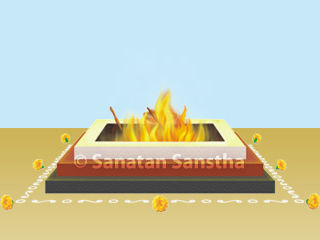
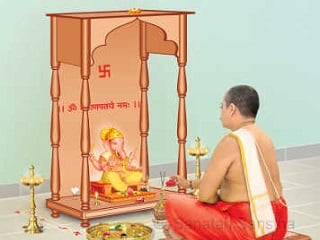 How to perform Puja Vidhi ?
How to perform Puja Vidhi ? Importance of Puja Samagri in ritualistic worship
Importance of Puja Samagri in ritualistic worship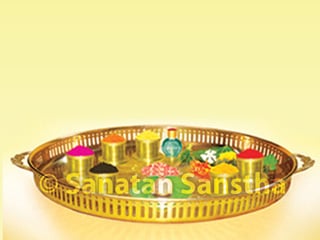 How to arrange the substances in Puja Thali ?
How to arrange the substances in Puja Thali ?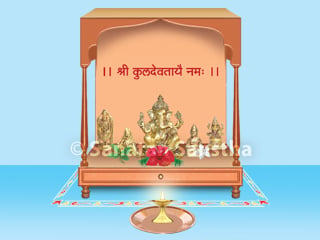 How should be the design of Devghar ?
How should be the design of Devghar ?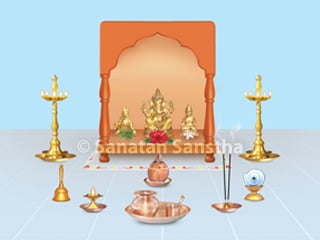 How to arrange the Puja items used in puja ?
How to arrange the Puja items used in puja ?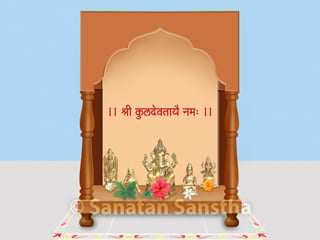 How to arrange Deities in Home temple ?
How to arrange Deities in Home temple ?